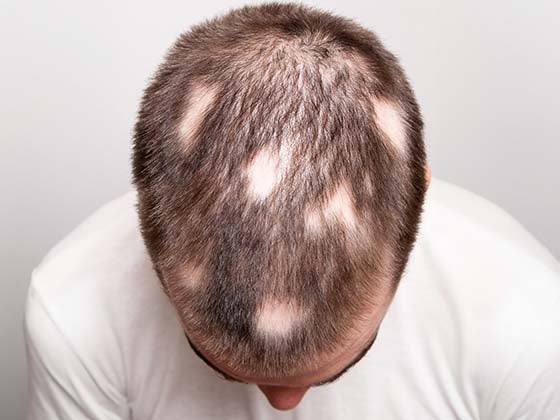Hair miniaturization occurs when the hair follicle contracts. Hair follicle shrinkage makes it difficult for hair to grow, resulting in thinner hairs with a brittle shaft that can easily fall off. This article will examine the causes, symptoms, and treatments for hair follicle shrinkage.
What is Hair Miniaturization?

Hair follicle miniaturization is a technical term for hair loss or baldness. This process, which mostly affects men, causes the hair follicle to constrict, making it difficult for hair to grow. This means that the follicle, which once produced healthy hairs, now produces thinner hairs with a brittle shaft that is easily shed. This resembles a receding hairline, thinner hair on top, or a bald spot. Some medications and treatments can help treat or prevent hair loss.
Definition and Overview
Miniaturization refers to the process of thinning hair. During shrinkage, hair follicles that were formerly healthy begin to produce thinner hairs with brittle shafts. Less dense hair can cause the appearance of thinning hair.
The Hair Growth Cycle and Miniaturization

Miniaturization is a hormone-driven biological process in which hairs diminish over time, eventually resulting in a bare scalp. The hair follicle growth cycle is divided into three stages: growth ("anagen"), transitional ("catagen"), and resting ("telogen").
Differences Between Hair Thinning and Miniaturization

Hair Thinning
-
Hair thinning is the gradual decline in the volume and density of hair. Genetics, hormonal fluctuations, stress, a bad diet, and certain medical problems can all contribute to this. Thinning hair frequently retains its natural thickness while becoming sparse over time.
-
Characteristics include reduced hair density, a visible scalp, a general decrease in overall hair volume, and hair that is still of normal thickness but in fewer numbers.
-
Causes include genetics (e.g., androgenetic alopecia), hormonal imbalances (e.g., thyroid disorders, menopause), and nutritional inadequacies. Stress and anxiety Certain drugs or medical treatments and poor hair care techniques.
-
Topical therapies (e.g., minoxidil), oral drugs (e.g., finasteride for males), dietary modifications (e.g., a well-balanced diet rich in vitamins and minerals), stress management strategies, scalp treatments and massages, and hair thickening products (e.g., shampoos and conditioners).
Hair Miniaturization
-
Hair miniaturization is a process in which hair follicles decrease over time, resulting in thinner, shorter, and more fragile hair strands. This disorder is frequently associated with androgenetic alopecia (pattern baldness) and is primarily caused by hormonal factors, specifically dihydrotestosterone (DHT).
-
Hair follicles shrink gradually, finer, shorter hair strands are produced, hair becomes less pigmented (lighter), the scalp becomes more visible in affected places, and hair growth from the tiny follicles eventually stops.
-
Causes include androgenetic alopecia (pattern baldness), hormonal sensitivity, particularly to DHT, and hereditary predisposition.
-
Treatment options include DHT blockers (e.g., finasteride), topical medications (e.g., minoxidil), hair transplant surgery (for advanced instances), low-level laser therapy (LLLT), platelet-rich plasma (PRP) therapy, and lifestyle adjustments (e.g., stress reduction, diet improvement).
Causes and Symptoms of Hair Miniaturization

Causes
Hair miniaturization may be caused by:
-
Genetics
-
Age
-
Dihydrotestosterone (DHT)
-
A combination of all three factors
-
DHT is a male sex hormone classified as an androgen. It is derived from testosterone and can cause hair loss.
-
Older people are more likely to develop hair miniaturization and male pattern baldness.
-
Baldness is caused by an X chromosome gene, so if your mother's father had hair miniaturization, you are more likely to develop it as well. However, it can also spread from the father's side.
Signs
-
Signs of hair loss and hair miniaturization are:
-
A receding hairline.
-
Thinning hair on the crown or top of the head
-
More hair on the pillow or in the shower drain
-
Hair loss following brushing or combing
-
a widening part
Common Causes of Hair Miniaturization

The common causes of hair miniaturization are listed below.
-
Genetics. The most common cause of hair miniaturization is androgenetic alopecia, a type of hair loss that is frequently inherited.
-
DHT. Dihydrotestosterone (DHT) is another common cause of hair shrinkage. DHT is a unique type of testosterone produced by the enzyme 5α-reductase. The rate at which this synthesis happens, and hence the amount of DHT present in the scalp, can vary substantially from one person to another. High levels of DHT may hurt the health and functionality of hair follicles, leading them to decrease over time and finally disappear.
-
Telogen Effluvium. Telogen Effluvium is a condition in which hair enters the resting phase, also known as the Telogen phase, of the hair growth cycle. As a result, the hair in the affected area thins over time. Hair miniaturization occurs when hair becomes thinner and finer as it grows. The most common causes of Telogen Effluvium are stress, physical trauma, prescription drugs, and nutritional deficiencies.
-
Nutritional Deficiency. Hair, like any other part of the body, requires the proper balance of protein, vitamins, minerals, and other hair-healthy nutrients to grow. Nutritional deficiencies can cause hair miniaturization indirectly by contributing to other health issues, so eating a well-balanced diet is important. Protein (particularly omega-3-rich salmon), gluten-free carbohydrates, vitamin C & E, biotin, zinc, magnesium, and iron are all good hair-care foods.
-
Natural Aging. Aging is probably the most common cause of hair miniaturization. There are several theories of aging, the two most well-known being the wear and tear theory and the free radical theory.
Identifying Symptoms Early
The first symptoms of balding may be so subtle that you do not notice them until your hair loss has progressed dramatically. In general, the initial indicators of balding are a receding hairline, increased hair loss, and a more visible scalp.
Role of DHT in Hair Miniaturization

There is evidence to suggest that genetics plays a role in hair loss in addition to DHT. Pattern hair loss, whether male or female, may be inherited. Experts believe the genetic component of pattern hair loss is polygenic. This suggests that it involves a large number of genes. Evidence suggests that the genes associated with pattern hair loss could include:
-
Androgen receptor gene
-
Estrogen receptor-beta gene
-
Aromatase gene
Diagnosing Hair Miniaturization

There is no truly scientific test to determine whether you are or will be experiencing hair miniaturization. However, many doctors and dermatologists may "grade" the hair using the Norwood scale. They may also conduct what is known as the pull or tug test, which you can try at home.
To perform the pull test:
-
Grab a section of hair (about 60 hairs) and hold it in two hands, one at the root and the other at the tip.
-
Gently pull upward to see if any of the strands break or completely come out.
- If more than three strands fall out, this could indicate hair miniaturization.
If a doctor suspects that the hair loss is due to an underlying medical condition, he or she may perform a blood test. If you suspect your hair is thinning, take photos of the top of your head every month to track its progress.
Medical Tests and Examinations

Hair miniaturization is the process by which hair follicles decrease over time, resulting in thinner, shorter, and less pigmented hair. This is usually connected with disorders such as androgenetic alopecia (pattern hair loss). Specific tests include a scalp biopsy, trichoscopy (dermatoscopy), hair pull test, phototrichogram, blood tests, hormone levels, and genetic testing.
Consulting a Dermatologist
If you want to slow hair loss, consult a doctor as soon as you notice signs of thinning. You have a better chance of slowing hair loss if you start treatment before you lose it. It is much easier to keep hair before it falls out than it is to regrow lost hair. You should also consult a doctor if your hair loss is severe and sudden, as this may indicate a more serious medical condition.
Monitoring Hair Density and Health
If your hair is too short to be measured in a ponytail, you can evaluate its density by looking at the scalp and how apparent it is, as well as how prominent or wide your part is. If you can see your scalp in different parts of your hair or throughout, you may have poor-density hair.
Treatments for Hair Miniaturization

There are clinical treatments that can treat or slow hair follicle miniaturization. These include the following:
-
Minoxidil: This FDA-approved medicine is also known by the brand name Rogaine. The medicine acts as a vasodilator, which means it widens and expands blood vessels. More blood can then reach the scalp, which is believed to aid with hair loss.
-
Finasteride: This is also an FDA-approved medicine, known as Propecia. Propecia works by decreasing the amount of the DHT hormone.
-
Hair transplants: These treatments include follicular unit transplantation (FUT) and follicular unit extraction (FUE). While the methods vary, these transplants operate by extracting hair follicles from the back of the head and transplanting them to places where hair is thinning.
-
Laser treatments: Low-level laser therapy (LLLT) may reduce inflammation in the hair follicles, allowing them to enlarge.
Topical Treatments and Medications

-
Topical Minoxidil: Minoxidil reduces hair thinning and stimulates new hair growth. This medication can help people with a variety of hair loss conditions, including male and female pattern hair loss, also known as androgenetic alopecia; alopecia areata, an autoimmune disease in which the body's immune system attacks healthy tissues, including hair follicles; telogen effluvium, in which hair falls out all over the scalp due to an interruption in the body's hair production cycle; and anagen effluvium, or rapid hair loss caused by medical.
-
Oral Finasteride: Oral finasteride is a prescription drug that treats male pattern hair loss, also known as androgenetic alopecia. Finasteride reduces hair loss and promotes new hair growth by suppressing the body's synthesis of a hormone that destroys hair follicles. This drug is given orally once per day and works best when taken at the same time every day. Finasteride begins to act after four months, but you may not see considerable hair growth for up to a year. Your dermatologist will assess this development after six months to determine whether to continue therapy. If the medicine is effective, treatment can be continued for as long as new hair growth is required. If you stop using the medicine, you may have hair loss again.
-
Antiandrogens: Female pattern baldness, also known as androgenetic alopecia, may be treated with medications that suppress androgens—sex hormones that damage or kill hair follicles—to prevent hair loss. Antiandrogen drugs, such as spironolactone and estrogen-containing oral contraceptives, are only available with a prescription. Antiandrogens typically begin to function after four months. Long-term treatment is required to prevent hair loss from reoccurring.
-
Corticosteroids: Corticosteroids are used to treat alopecia areata, lichen planopilaris, and discoid lupus erythematosus. These immune system suppressors can alleviate the symptoms of an autoimmune condition, allowing hair to grow. Steroids are available as topical applications or injections, and they all require a prescription. Dermatologists recommend the best treatment for you based on your age and the severity of your symptoms.
-
Antifungal Medications: If a fungal condition known as tinea capitis, or scalp ringworm, is the cause of hair loss, a dermatologist will prescribe an antifungal drug to be taken orally once daily. Often, it takes one or two months to notice effects, and therapy often lasts several months to completely eliminate the fungus. Most patients see great hair regrowth when treatment begins soon after symptoms appear. Antifungal drugs might cause redness, diarrhea, and an upset stomach.
Lifestyle Changes to Combat Hair Loss

Natural treatments for hair loss include:
-
Viviscal: This natural hair-growth supplement contains minerals, vitamins, as well as shark and mollusk powder.
-
Ginseng: This supplement might encourage the growth of hair by stimulating hair follicles.
-
Rosemary oil: This oil can be massaged into the scalp after being mixed with a carrier oil. Rosemary is particularly effective for treating male pattern baldness. You can even mix a few drops into your shampoo and conditioner. Just avoid applying the oil directly, since it can burn.
-
Geranium oil: This hair oil has the ability to improve scalp circulation, which is also how some prescription treatments work to delay the onset of baldness.
-
Biotin: This supplement might fortify hair, but it will not guarantee hair growth.
-
Saw palmetto: More research is required, but this berry plant may help with hair loss.
-
Lifestyle changes: Hair loss may also be slowed by making certain lifestyle adjustments, such as giving up smoking and eating a better diet.
Nutritional Support for Hair Health

When vitamin levels drop too low, hair follicles struggle to maintain healthy hair growth. Nutrient deficiency disrupts their complex processes, putting hair at risk. Deficiencies can result in excessive shedding, slow growth, thinning, dull and dry strands, textural changes, and uneven hair loss.
Conclusion: Managing and Reversing Hair Miniaturization

Managing and reversing hair shrinkage is a long-term commitment that requires perseverance and consistency. It is possible to slow or even reverse the process of hair loss by combining medical treatments, lifestyle changes, and regular monitoring.
















